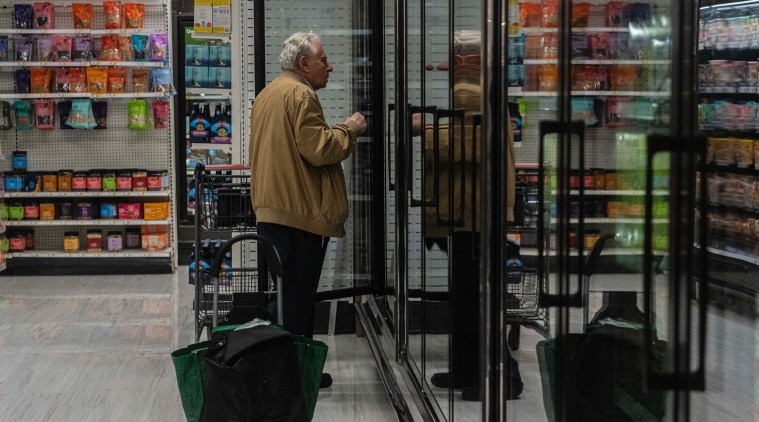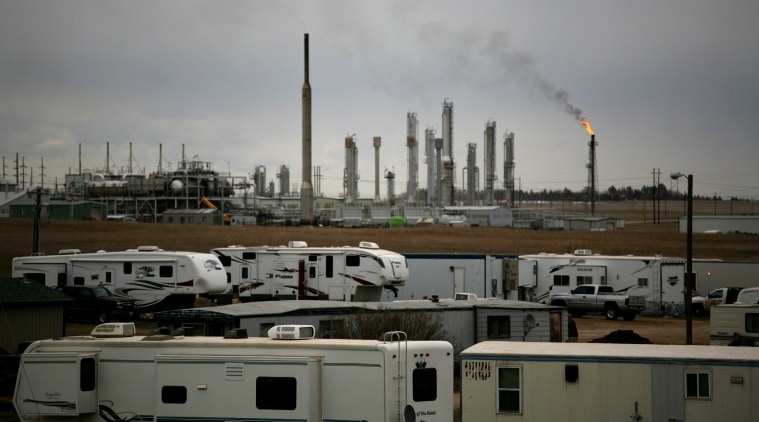How this economic moment rewrites the rules
Cryptopolytech Public Press Pass
Title: How this economic moment rewrites the rules
Originally reported on indianexpress.com by New York Times
•| World News | Classification: IPTC: 01026002 • IAB-QAG: IAB12-1
To understand the strange, conflicting signals being sent by the U.S. economy right now, it helps to look at Williston, North Dakota, in about 2010.
North Dakota was in the midst of an oil boom. Scores of rigs were drilling hundreds of wells, filling up train cars with crude because there hadn’t been time to build a pipeline. Pretty much anyone who wanted a job could find one, even the teenagers who dropped out of high school to work in the oil fields. Wages soared. Fast-food restaurants offered signing bonuses. State coffers filled up with tax revenue.
Yet as good as the economy was, it also felt unstable. Restaurants couldn’t hire enough workers. Housing was in short supply, and costly. Local infrastructure couldn’t withstand the sudden surge in demand. Prices for practically everything soared.
“It was chaotic,” said David Flynn, an economist at the University of North Dakota who lived through the boom and has studied it. “The economy was doing well, revenues for the local areas were up across the board, but you were still short of workers and businesses were having trouble.”
“That sounds a lot like the stories you’ve been hearing at the national level for the past couple years,” he added.
Economists and politicians have spent weeks arguing about whether the United States is in a recession. If it is, the recession is unlike any previous one. Employers added more than half a million jobs in July, and the unemployment rate is at a half-century low.
Typically, in recessions, the problem is that businesses don’t want to hire and consumers don’t want to spend. Right now, businesses want to hire, but can’t find the workers to fill open jobs. Consumers want to spend, but can’t find cars to buy or flights to book.
Pickups fill the parking lot of a motel in Williston, N.D., where oil boom workers had to find alternatives to more traditional housing options, March 29, 2010. To understand the strange, conflicting signals being sent by the U.S. economy right now, it helps to look at Williston, N.D., in about 2010. (Todd Heisler/The New York Times)
Recessions, in other words, are about too much supply and too little demand. What the U.S. economy is facing is the opposite. Just like North Dakota in 2010.
The underlying causes are different, of course. Williston was hit by a surge in demand as companies and workers flooded into what had been a small city in the Northern Plains. The United States was hit by a pandemic, which caused a shift in demand and disrupted supply chains around the world. And the comparison goes only so far: Williston’s population roughly doubled from 2010 to 2020. No one expects that to happen to the country as a whole.
Still, whether local or national, the most obvious consequence is the same: inflation. When demand outstrips supply — whether for steel-toe boots in an oil boomtown or for restaurant seats in the aftermath of a pandemic — prices rise. Flynn recalled going out to eat during the boom and discovering that hamburgers cost $20, a feeling of sticker shock familiar to practically any American these days.
There is also a subtler consequence: uncertainty. No one knows how long the boom will last, or what the economy will look like on the other side of it, which makes it hard for workers, businesses and governments to adapt. In Williston, companies and governments were reluctant to invest in the apartment buildings, elementary schools and sewage-treatment plants that the community suddenly needed — but might not need by the time they were complete.
“Think of it as a situation of every day, seemingly, was a new shock, so you couldn’t even adjust before a new one was hitting,” Flynn said. “It’s that constant adjustment. Completely unpredictable.”
Businesses have now spent 2 1/2 years in a state of constant adjustment. In early 2020, practically overnight, Americans traded restaurant meals for home-baked bread, and gym memberships for socially distanced bike rides. Those shifts caused huge disruptions, in part because businesses were reluctant to make long-term investments to address short-term spikes in demand.
 A convenience store in Manhattan, July 13, 2022. If the U.S. is in a recession it is unlike any previous one: employers added more than half a million jobs in July and the unemployment rate is at a half-century low. (Hiroko Masuike/The New York Times)
A convenience store in Manhattan, July 13, 2022. If the U.S. is in a recession it is unlike any previous one: employers added more than half a million jobs in July and the unemployment rate is at a half-century low. (Hiroko Masuike/The New York Times)
“That was always going to cause its own problems on prices and shortages,” said Adam Ozimek, chief economist for the Economic Innovation Group, a Washington research organization. “Businesses were never going to be like, ‘I’m going to build 10 new bicycle factories right now because we’re in a long-term bicycling boom.’”
Some other shifts caused by the pandemic are likely to prove longer lasting. But it is hard for businesses to know which.
“I think businesses are correct that the current state of the economy can’t really hold — something has to give,” Ozimek said.
To most people, of course, this doesn’t feel like a boom. Measures of consumer confidence are at record lows, and Americans overwhelmingly say they are dissatisfied with the economy. That perception is grounded in reality: High inflation is eroding — and in some cases erasing — the benefits of a strong job market for many workers. Hourly earnings, adjusted for inflation, are falling at their fastest pace in decades.
“I know people will hear today’s extraordinary jobs report and say they don’t see it, they don’t feel it in their own lives,” President Joe Biden said Friday. “I know how hard it is. I know it’s hard to feel good about job creation when you already have a job and you’re dealing with rising prices — food and gas and so much more. I get it.”
Tara Sinclair, an economist at George Washington University, said the United States wasn’t experiencing a true boom. That would imply a virtuous circle, in which prosperity begets investment, which begets more prosperity and makes the economy more productive in the long term — a rising tide that lifts all boats.
Instead, the lingering disruptions of the pandemic, uncertainty over what the post-COVID economy will look like and fears of a recession have made businesses reluctant to make bets on the future. Business investment fell in the most recent quarter. Employers are hiring, but they are leaning heavily on one-time bonuses rather than permanent pay increases.
“It’s not an economic boom in the sense of wanting to invest long term,” Sinclair said. “It’s a boomtown situation where everyone’s just waiting for it to get cut off.”
Indeed, the Federal Reserve is trying to cut it off. Jerome Powell, the Fed chair, has described the labor market, with twice as many open jobs as unemployed workers, as “unsustainably hot,” and is trying to cool it through aggressive interest rate increases. He and his colleagues have argued repeatedly that a more normal economy — less like a boomtown, with lower inflation — will be better for workers in the long term.
“We all want to get back to the kind of labor market we had before the pandemic, where differences between racial and gender differences and that kind of thing were at historic minimums, where participation was high, where inflation was low,” Powell said last month. “We want to get back to that. But that’s not happening. That’s not going to happen without restoring price stability.”
Biden and his advisers, too, have argued that a cooling economy is inevitable and even necessary as the country resets from its reopening-fueled surge. In an opinion article in The Wall Street Journal in May, Biden warned that monthly job growth was likely to slow, to around 150,000 a month from more than 500,000, in “a sign that we are successfully moving into the next phase of the recovery.”
So far, that transition has been elusive. Forecasters had expected hiring to slow in July, to a gain of about 250,000 jobs. Instead, the figure was above 500,000, the highest in five months, the Labor Department reported on Friday. But the labor force — the number of people who are either working or actively looking for work — shrank and remains stubbornly below its pre-pandemic level, a sign that the supply constraints that have contributed to high inflation won’t abate quickly.
 Campers near a refinery in Williston, N.D., where oil boom workers had to find alternatives to more traditional housing options, April 1, 2010. To understand the strange, conflicting signals being sent by the U.S. economy right now, it helps to look at Williston, N.D., in about 2010. (Todd Heisler/The New York Times)
Campers near a refinery in Williston, N.D., where oil boom workers had to find alternatives to more traditional housing options, April 1, 2010. To understand the strange, conflicting signals being sent by the U.S. economy right now, it helps to look at Williston, N.D., in about 2010. (Todd Heisler/The New York Times)
Sinclair said it shouldn’t be surprising that it was taking time to readjust after the coronavirus disrupted nearly every aspect of life and work. As of July, the U.S. economy, in the aggregate, had recovered all the jobs lost during the early weeks of the pandemic. But beneath the surface, the situation looks drastically different from what it was in February 2020. There are nearly half a million more warehouse workers today, and nearly 90,000 fewer child care workers. Millions of people are still working remotely. Others have changed careers, started businesses or stopped working.
“We have to remember that we are still sorting that out,” Sinclair said. “It was a big economic shock, and the fact that we came out of it as quickly as we did is still incredibly impressive. These residual pains are us just still adjusting to it.”
‘News of the Day’ content, as reported by public domain newswires.
Source Information (if available)
It appears the above article may have originally appeared on indianexpress.com and has been shared elsewhere on the internet, repeatedly. News articles have become eerily similar to manufacturer descriptions.
We will happily entertain any content removal requests, simply reach out to us. In the interim, please perform due diligence and place any content you deem “privileged” behind a subscription and/or paywall.
First to share? If share image does not populate, please close the share box & re-open or reload page to load the image, Thanks!


